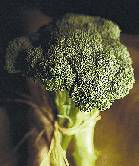Broccoli Compound May Help COPD Patients
Sulphoraphane boosts lungs' antioxidant activity, researchers explain.
By Steven Reinberg
HealthDay Reporter
|
E-mail this article
Subscribe to news
Printer friendly version
|

(SOURCES: Shyam Biswal, Ph.D., associate professor, department of environmental health sciences and the division of pulmonary and critical care medicine, Johns Hopkins School of Medicine, Baltimore; Norman H. Edelman, M.D., professor, preventive medicine, internal medicine, physiology & biophysics, State University of New York, Stony Brook, N.Y.; Sept. 15, 2008, American Journal of Respiratory and Critical Care Medicine)
FRIDAY, Sept. 12 (HealthDay News) -- People with chronic obstructive pulmonary disease (COPD) could one day benefit from an antioxidant compound in broccoli, researchers report.
COPD is the fourth-leading cause of death in the United States, affecting more than 16 million people, and is often the result of long-term smoking. There is no cure for this deadly disease, and current drugs do not slow its progression.
"In COPD, there is critical loss of antioxidant systems, which protect against oxidative stress and inflammation," explained lead researcher Shyam Biswal, an associate professor in the department of environmental health sciences and the division of pulmonary and critical care medicine at Johns Hopkins School of Medicine, in Baltimore.
"Even though there is a loss of this system, you can substantially restore it with an activator for this pathway," Biswal said. A compound in broccoli called sulforaphane has been shown effective in restoring antioxidant gene activity. "So this could be a new way of doing therapy," Biswal theorized.
The study is published Sept. 15 in the American Journal of Respiratory and Critical Care Medicine.
One of the things that was not understood before this work was why COPD patients carry a lot of oxidative stress, Biswal said. "Now we know the defense system in the lungs is getting lost -- but there is a hope that you can turn it on," he said. "Now that we know the target, we have to develop a therapy and see how effective it is."
Biswal noted that the big problem in COPD is not repairing the damage done to the lungs but rather preventing bacterial infection. "Most COPD patients manifest infection in the lungs and they die from that," he said.
What the researchers found is that a gene called NRF2 (nuclear factor erythroid-derived 2-related factor 2) works as a master gene that turns on many antioxidant and pollutant-detoxifying genes that protect the lungs from environmental pollutants, such as cigarette smoke.
However, levels of the protein produced by NRF2, and one of its regulators, DJ-1, are lower in COPD patients compared with patients without the disease. those levels are associated with the severity of the condition.
For this study, Biswal's group took lung tissue samples from smokers with and without COPD. The researchers compared the samples to see if there was a difference in the levels of NRF2 between people with and without COPD.
They also looked at levels of two biochemical regulators of NRF2, KEAP1 (which inhibits NRF2) and DJ-1 (which stabilizes it).
Biswal's team found that COPD patients had significantly lower levels of NRF2-dependent antioxidants, increased oxidative stress markers and a significant decrease in NRF2 protein, compared with non-COPD patients.
They also found that both groups had similar levels of KEAP1, but among COPD patients levels of DJ-1 was significantly lower. All of this indicates that NRF2 was there, but had been degraded.
So, agents that target NRFS -- including the sulforaphane found in broccoli -- might someday be harnessed to give the natural antioxidant systems of COPD patients a boost.
These strategies might prove effective in treating the disease, Biswal said. "It could be more effective, but a lot of study needs to be done," he said.
Dr. Norman H. Edelman, a professor of preventive medicine, internal medicine, physiology and biophysics at the State University of New York, Stony Brook, said the research is promising but far from having any treatment implications.
"The finding is of scientific importance because it may reveal a common pathway for antioxidant deficiency in COPD lungs," Edelman said. "Despite the talk of having clinical relevance, I would think that this is a long way off," he said.
More information
For more information on COPD, visit the U.S. National Library of Medicine .
Copyright © 2008 ScoutNews, LLC. All rights reserved. 
HealthDayNews articles are derived from various sources and do not reflect federal policy. healthfinder.gov does not endorse opinions, products, or services that may appear in news stories. For more information on health topics in the news, visit the healthfinder.gov health library.